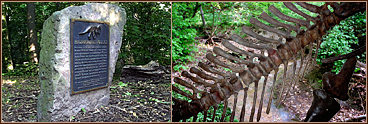

|

...

|
|
A bronze and stone marker (left) In Haddonfield, N.J. commemorates the site where the skeleton of Hadrosaurus foulkii (right) was unearthed in 1858.
|
|
|
In the summer of 1858, Victorian gentleman and fossil hobbyist William Parker Foulke was vacationing in Haddonfield, New Jersey, when he heard that twenty years previous, workers had found gigantic bones in a local marl pit. Foulke spent the the late summer and fall directing a crew of hired diggers shin deep in gray slime. Eventually he found the bones (above, right) of an animal larger than an elephant with structural features of both a lizard and a bird.
First Nearly-Complete Dinosaur Skeleton
Foulke had discovered the first nearly-complete skeleton of a dinosaur -- an event that would rock the scientific world and forever change our view of natural history.
Today, located where a tidy suburban street dead ends against deep woods, the historic site is marked with a modest commemorative stone (above, left) and a tiny landscaped park. Just beyond the stone the ground drops away into the steep ravine where the bones of Hadrosaurus foulkii were originally excavated on the eve of the Civil War.
The "Ground Zero" of Dinosaur Paleontology
In relation to the history of dinosaur paleontology, this Haddonfield Hadrosaurus site is ground zero; the spot where our collective fascination with dinosaurs began. Visitors can still climb down crude paths into the 30-foot, vine-entangled chasm to stand in an almost primordial quiet at the actual marl pit where the imagination of all mankind was exploded outward to embrace the stunning fact that our planet was once ruled by fantastically large, bizarrely shaped reptilian creatures.
|
All Rights Reserved © 1995 - 2008, Hoag Levins
HoagL@earthlink.net
.
|


|




